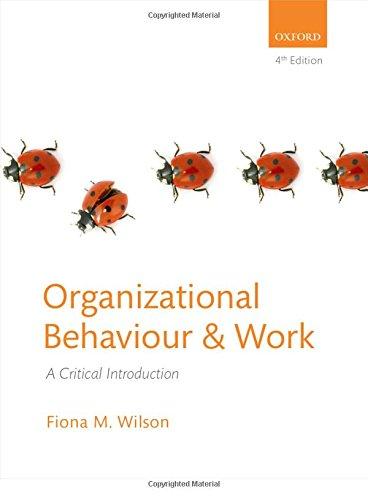T his case looks at a researcher who was keen to investigate how to lead to bring
Question:
This case looks at a researcher who was keen to investigate how to lead to bring about change in a democratic way. Kurt Lewin and his associates were keen to demonstrate the advantages of democratic decision making. They set up an experiment to compare the effects of a lecture and a group decision on behaviour. They wanted to change the food habits of housewives in order to help the war effort.
Six groups of Red Cross volunteers, ranging in size from thirteen members to seventeen, were used. The objective was to increase the use in cooking of cow’s hearts, sweetbreads (pancreas or thymus gland), and kidneys. In three groups, ‘attractive’ lectures (Lewin, 1959; 202) were given, which likened the problem of nutrition with the war effort, emphasized the vitamin and mineral value of the three meats, and gave detailed explanations with the aid of charts. Both the health and eco¬ nomic aspects were stressed. The preparation of these meats was discussed in detail, including techniques for avoiding aversion to odour, texture, and appearance. Recipes were distributed; the lecturer gave hints on her own methods for preparing these ‘delicious dishes’ and mentioned her success with her own family (Lewin, 1959).
In the other three groups, the problem of nutrition was linked to the war effort and general health in a discussion. Could the housewives be induced to participate in a programme of change without attempting any ‘high-pressure salesmanship’ (Lewin, 1959)? The group discussion about ‘house¬ wives like themselves’ led to an elaboration of the obstacles that this change would encounter, such as distaste, or smell during cooking. The nutrition expert offered the same remedies and recipes for preparation that had been presented in the lectures to the other groups—but in these groups, prepa¬ ration techniques were offered after the groups had become sufficiently involved to be interested in whether certain obstacles could be removed.
Near the start of the meeting, a show of hands demonstrated how many women had served any of these foods in the past. At the end of the meeting, the women were asked whether they were willing to try one of these meats in the next week. Only 3 per cent of those who heard the lectures served one of the meats never served before; of those attending the group decision, 32 per cent served one of the meats.
Lewin (1959) explained why the group discussion produced these results. Firstly, lecturing is a pro¬ cedure in which the audience is chiefly passive; discussion is likely to lead to a much higher degree of involvement. Further, it is easier to change the ideologies and social practices of a small group han¬ dled together than those of single individuals. An individual in a small group is more likely to change if the group changes. (This is the practice adopted by those involved with alcoholics.)
It is interesting that Lewin himself notes that the difference between the resuits of the lectures and the group decision may be due to the fact that only after the group decision did the discussion leader mention that an inquiry would be made later as to whether a new food was introduced into the family diet. The ‘threat’ of follow-up in itself may therefore have influenced the results. It is also interesting that no mention is made of the gender of the nutrition ‘expert’—but the discussion group appears to have been run by a male called Mr Bavelas, who was an experienced group worker ‘and doubtless of unusual ability in this field’ (Lewin, 1959: 204), while the lecture was given by a female, a housewife . This, too, may have influenced the results—but Lewin does not consider the effect of this variable.
Questions
1. What are the main lessons of Lewin’s experiment for leaders and managers trying to influence groups
in organizations?
2. What are the flaws with Lewin’s food experiment?
Step by Step Answer:

Organizational Behaviour And Work A Critical Introduction
ISBN: 9780199645985
4th Edition
Authors: Fiona M. Wilson





